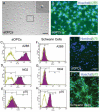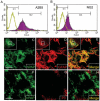Schwann cell-like differentiation by adult oligodendrocyte precursor cells following engraftment into the demyelinated spinal cord is BMP-dependent
- PMID: 16921543
- PMCID: PMC2813493
- DOI: 10.1002/glia.20369
Schwann cell-like differentiation by adult oligodendrocyte precursor cells following engraftment into the demyelinated spinal cord is BMP-dependent
Abstract
The development of remyelinating strategies designed to enhance recruitment and differentiation of endogenous precursor cells available to a site of demyelination in the adult spinal cord will require a fundamental understanding of the potential for adult spinal cord precursor cells to remyelinate as well as an insight into epigenetic cues that regulate their mobilization and differentiation. The ability of embryonic and postnatal neural precursor cell transplants to remyelinate the adult central nervous system is well documented, while no transplantation studies to date have examined the remyelinating potential of adult spinal-cord-derived oligodendrocyte precursor cells (adult OPCs). In the present study, we demonstrate that, when transplanted subacutely into spinal ethidium bromide/X-irradiated (EB-X) lesions, adult OPCs display a limited capacity for oligodendrocyte remyelination. Interestingly, the glia-free environment of EB lesions promotes engrafted adult OPCs to differentiate primarily into cells with immunophenotypic and ultrastructural characteristics of myelinating Schwann cells (SCs). Astrocytes modulate this potential, as evidenced by the demonstration that SC-like differentiation is blocked when adult OPCs are co-transplanted with astrocytes. We further show that inhibition of bone morphogenetic protein (BMP) signaling through noggin overexpression by engrafted adult OPCs is sufficient to block SC-like differentiation within EB-X lesions. Present data suggest that the macroglial-free environment of acute EB lesions in the ventrolateral funiculus is inhibitory to adult spinal cord-derived OPC differentiation into remyelinating oligodendrocytes, while the presence of BMPs and absence of noggin promotes SC-like differentiation, thereby unmasking a surprising lineage fate for these cells.
Figures







References
-
- Akiyama Y, Honmou O, Kato T, Uede T, Hashi K, Kocsis JD. Transplantation of clonal neural precursor cells derived from adult human brain establishes functional peripheral myelin in the rat spinal cord. Exp Neurol. 2001;167:27–39. - PubMed
-
- Blakemore WF. Remyelination by Schwann cells of axons demye-linated by intraspinal injection of 6-aminonicotinamide in the rat. J Neurocytol. 1975;4:745–757. - PubMed
-
- Blakemore WF. Limited remyelination of CNS axons by Schwann cells transplanted into the sub-arachnoid space. J Neurol Sci. 1984;64:265–276. - PubMed
-
- Blakemore WF. The case for a central nervous system (CNS) origin for the Schwann cells that remyelinate CNS axons following concurrent loss of oligodendrocytes and astrocytes. Neuropathol Appl Neurobiol. 2005;31:1–10. - PubMed
Publication types
MeSH terms
Substances
Grants and funding
LinkOut - more resources
Full Text Sources

